Abstract According to the statistics of major machine tool manufacturing and market in the world, the development and future trends of the global machine tool market in 2014 will be briefly introduced and analyzed. First, the world's major machine tool manufacturing and market
Based on the statistics of the world's major machine tool manufacturing and market, the following is a brief introduction and analysis of the development of the global machine tool market in 2014 and the future trends. First, the world's major machine tool manufacturing and market
1. US manufacturing industry returns to drive the growth of machine tool consumption
According to statistics from the American Machinery Manufacturing Technology Association (AMT), the total volume of orders for metalworking machines in the United States in 2014 was US$5.08 billion, an increase of 3.1% year-on-year. Among them, the total order for gold cutting machine tools was US$4.94 billion, up 3.7% year-on-year; the total order for metal forming machine tools was US$140 million, down 14.2% year-on-year. In terms of regional distribution, orders in the central and eastern regions grew fastest, with orders for metalworking machine tools totaling US$ 1.37 billion, a year-on-year increase of 6.6%. Among them, gold cutting machine orders totaled 1.31 billion US dollars, an increase of 7.1%; metal forming machine orders totaled 0.6 billion US dollars, down 3.1%.
“From the end of 2014, the trend analysis of 2015 is more optimistic. At the same time, many major manufacturers also said that they plan to hire more employees and increase more investment in the coming months.†AMT Chairman Douglas Wood said, “In 2014, orders increased by 3.1% to meet our annual expectations. Although there are some unfavorable factors (such as the appreciation of the US dollar, the fall in oil prices and the shortage of skilled workers), we believe that the United States in the first half of 2015 as a whole. The economy will continue to pick up and be in a manageable state."
In 2014, the US cutting tool consumption reached US$2.04 billion, a year-on-year increase of 5.9%, showing a volatility trend. The average monthly spending in 2014 was $170 million, an increase of $9.66 million from 2013 (see Figure 1).
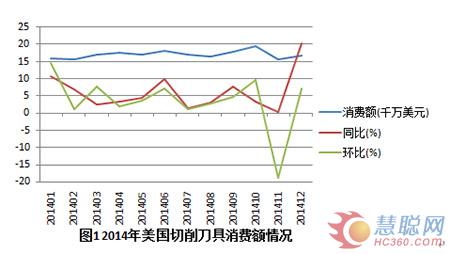
According to statistics from the Japan Machine Tool Industry Association (JMTBA) on metal cutting machine tools, the total order of Japanese machine tools in 2014 was 1.5094 billion yen (about 14 billion US dollars), an increase of 135.1%. Among them, the total order of CNC machine tools was 1,744.2 billion yen (about 13.9 billion US dollars), an increase of 135.7%. Domestic demand in Japan was 496.4 billion yen (about 4.6 billion US dollars), an increase of 123.8% year-on-year; exports were 1,013 billion yen (about 9.4 billion US dollars), an increase of 141.4% year-on-year (see Figure 2, Figure 3, Figure 4) .
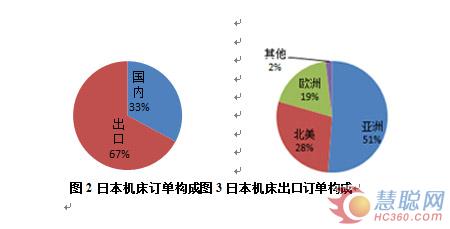
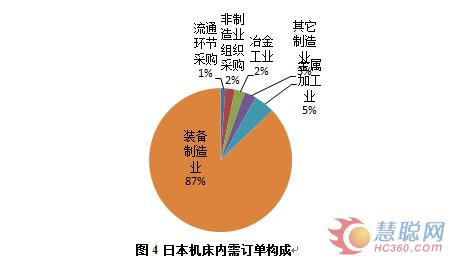
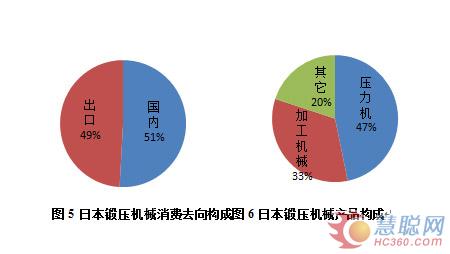
3. German re-industrialization promotes local high-end demand growth
According to statistics from the first three quarters of the German Machine Tool Industry Association in 2014, the total order value of machine tools was 10.79 billion euros, down 1% year-on-year. Among them, orders from China were 3.84 billion euros, an increase of 8% year-on-year; orders for exports were 6.95 billion euros, down 3% year-on-year. The German machine tool market consumption was 4.97 billion euros, an increase of 7% year-on-year (see Figure 7).
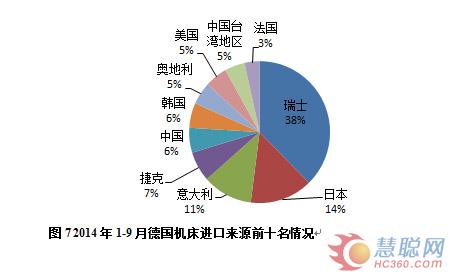
The top three importers of machine tools in Germany are: lathes (330 million euros, up 15% year-on-year), special processing machines (310 million euros, up 14.1% year-on-year), and machining centers (270 million euros, up 12% year-on-year) .
Due to factors such as energy and population, the German machine tool market is also facing an upgrade process of re-industrialization. It can be seen from the growth of German market consumption, machine tool output and imports that consolidating and upgrading the traditional competitive advantage of the German machine tool industry is still the core goal of re-industrialization. At the same time, German machine tool overseas orders and exports have shown a year-on-year decline in the context of the increasingly diverging world economic cycle, the increasing demand for the world's major machine tool consumer market, and the increasing competitiveness of German machine tool products.
4. Taiwan's export-oriented industries, cross-strait relations continue to improve
According to the statistics of the Taiwan Machinery Industry Association in 2014, the export value was 3.75 billion US dollars, an increase of 5.8% year-on-year (see Figure 8).
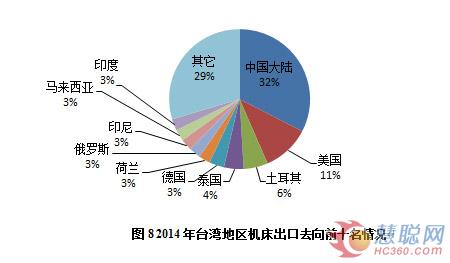
From the market data in 2014, the world's major machine tool consumer markets and manufacturing industries have adopted policies, measures and means to promote manufacturing reflow, re-industrialization and industrial upgrading, etc., to build, consolidate and upgrade their own in the global machine tool manufacturing industry. The dominant position. The reason may be in the following aspects:
(1) The modernization and competitiveness of the machine tool manufacturing industry is the foundation of the national industrial modernization. The national industrial modernization is the fundamental embodiment of the competitiveness of the great powers and the guarantee of the steady development of the economy.
(2) The machine tool manufacturing industry, especially the medium and high-end machine tool manufacturing industry, is often a necessary strategic pillar in the economic and industrial systems for large countries, and does not fully apply the "comparative advantage trade theory" in economics.
(3) At present, the development of the real economy such as manufacturing has become a major starting point for the developed countries to solve the socialization and development of strategic issues such as the lack of employment and economic development. The machine tool manufacturing industry has provided important support for achieving the above-mentioned national strategic goals.
The above reason is that Chinese buyers can buy first-class steel and automobile companies in Europe and America, but it is difficult to effectively cooperate with first-class machine tools, numerical control systems and functional components companies no matter how much money they make. At the same time, this is why the economic and information industry developed countries such as Europe and the United States have to turn their heads to engage in manufacturing and re-industrialization.
Looking at the breakdown of the world's major machine tool market data and industry operations in 2014, the future development trend of the global machine tool industry and market will show the following changes.
(1) The US economic recovery will become increasingly obvious. Driven by the manufacturing industry's return, the growth momentum of the machine tool market will continue to increase.
(2) The positive fiscal and monetary policies currently adopted by the Japanese government are conducive to the development of its export-oriented machine tool industry, and are also conducive to expanding and stimulating the concentrated release of domestic demand in the near future. Therefore, it will continue to maintain a rapid growth trend for some time to come.
(3) Although the German machine tool manufacturing industry has grown in terms of export and internal re-industrialization, too high social costs, large internal transformation pressures, shrinking traditional markets and more intense external competition are all recent operations. Set a lot of resistance.
(4) Emerging countries, economies and regions (especially in Southeast Asia) have taken advantage of the latter to attract the global manufacturing industry chain to re-lay, and its economy and market scale are maintaining rapid growth. In the future, the above areas will be an important hotspot for machine tool consumption. (Association Information Statistics Department Du Zhiqiang)
Outdoor Wall Sconce,Outdoor Lamp Wall Sconce,Outdoor Wall Lantern,Modern Outdoor Wall Lamp
Zhengdong Lighting Co., Ltd. , https://www.sundint.com